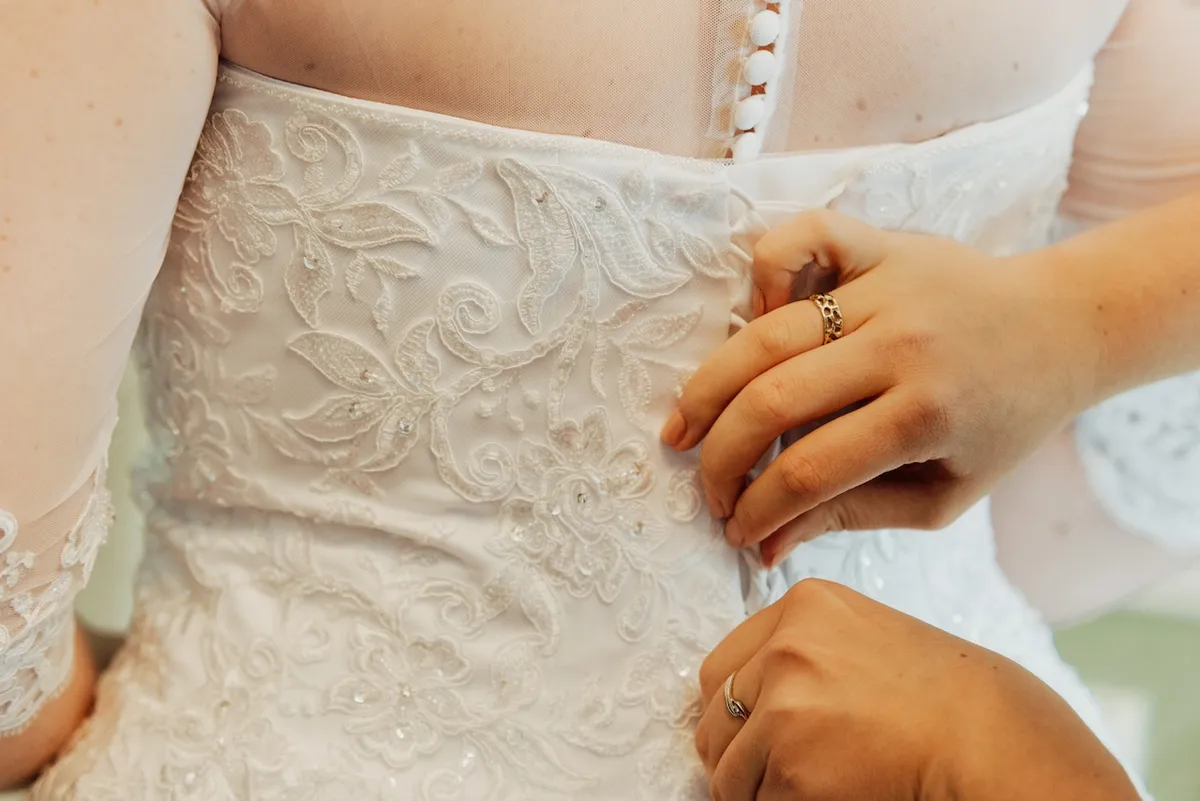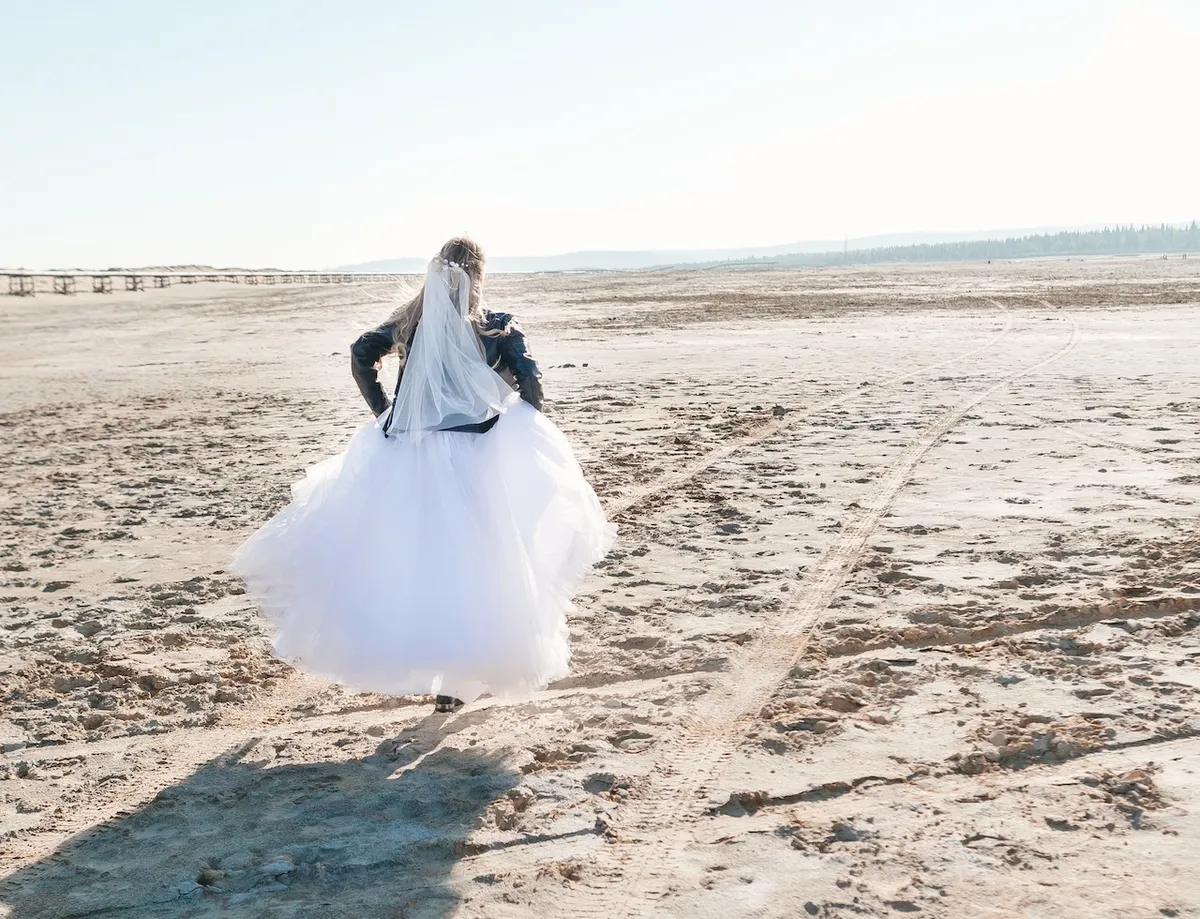
Choosing the perfect wedding dress can be a thrilling yet confusing task for many brides-to-be. Across the globe, cultures celebrate marriage with an array of colors and attire that go beyond the classic white gown.
This article will explore wedding dress customs from different parts of the world, revealing how traditional garments reflect cultural values and beliefs. Dive in to discover why these time-honored traditions continue to captivate and inspire!
Traditional Wedding Dresses Around the World
From the iconic red wedding dresses in China to the vibrant colors of Moroccan bridal attire, traditional wedding dresses around the world vary widely in style and symbolism. In Vietnam, the ao dai is a popular choice for brides, while Indian brides often don stunning saris.
Meanwhile, Nigerian brides opt for gele headpieces and buba tops for their special day.
China (red)
In China, brides often wear red on their wedding day. Red is a powerful color in Chinese culture. It stands for good luck and joy. The traditional bridal gown is called a 'qipao' or 'cheongsam'.
This dress is tight-fitting with beautiful patterns that can include golden dragons and phoenixes. These symbols bring extra blessings to the marriage.
Many weddings also have the bride changing outfits several times. Each dress shows respect for tradition and family. The wedding isn't only about two people joining together but joining two families as well.
So wearing red honors this important day and all it means for everyone involved.
Morocco (bright colors)
Moroccan wedding dresses are known for their vibrant and bright colors, reflecting the lively and festive nature of Moroccan culture. Brides often wear elaborate gowns adorned with intricate embroidery, beading, and colorful patterns, creating a stunning visual display.
The use of bold hues such as blues, greens, oranges, and pinks adds to the joyous atmosphere of the wedding celebration, making the bride's attire a focal point of the festivities.
The traditional Moroccan wedding dress is an embodiment of rich cultural heritage and symbolizes joy, prosperity, and happiness. These colorful garments showcase the artistry and craftsmanship prevalent in Moroccan fashion traditions while adding a sense of warmth and cheer to the occasion.
Vietnam (ao dai)
In Vietnam, the traditional wedding attire for women is called "ao dai." This outfit consists of a long tunic with slits on the sides, worn over wide-legged pants. The ao dai is typically made from luxurious silk and often adorned with intricate embroidery or beadwork, reflecting Vietnamese craftsmanship and artistry.
Its design emphasizes elegance and modesty while accentuating the feminine silhouette. The ao dai is usually in vibrant colors like red, pink, or pastel hues, symbolizing luck, happiness, and prosperity according to Vietnamese cultural beliefs.
India (sari)
In India, the traditional wedding dress for women is the sari. The sari is a long piece of cloth that is draped elegantly around the body, and it comes in a variety of colors and designs.
It holds great cultural significance and represents the grace and beauty of Indian women. The bride's choice of sari often reflects her personal style, with some opting for bright and vibrant hues while others prefer more subtle tones, making it a stunning representation of diversity in Indian bridal fashion traditions.
Nigeria (gele and buba)
In Nigeria, brides traditionally wear a colorful and elegant ensemble called "gele and buba." The gele is a headscarf tied in elaborate shapes, while the buba is a loose-fitting blouse paired with a long, flowing wrapper.
These garments are often made from luxurious fabrics like silk or lace and come in vibrant colors and intricate patterns to symbolize joy, prosperity, and cultural heritage. Additionally, the gele serves as more than just an accessory; it holds significance as a form of communication through its different tying styles.
The bridal attire customs in Nigeria encapsulate the rich cultural diversity and artistry of the country's traditional wedding clothing traditions. The geles' bold colors evoke feelings of celebration and festivity - an important aspect of global bridal attire that reflects diverse wedding dress symbolism worldwide.
Unique Wedding Dress Customs
Kenya is known for its beautiful beaded headpieces worn as part of the traditional wedding attire, adding a unique and colorful touch to the bride's ensemble. In Peru, the cholita dress is a symbol of indigenous pride and tradition, representing a fusion of Andean and Spanish influences in bridal fashion.
Kenya (beaded headpieces)
In Kenya, traditional wedding attire often includes stunning beaded headpieces. These headpieces are meticulously crafted with colorful beads and are worn by the bride to symbolize beauty, culture, and tradition.
The intricate beadwork on these headpieces is a significant part of Kenyan weddings, adding a touch of elegance and cultural pride to the bridal ensemble.
The beaded headpieces in Kenya hold deep cultural significance, representing the rich heritage and artistry of the local communities. Adorned with vibrant beads in various patterns and designs, these headpieces are an essential element of the bride's attire, embodying centuries-old traditions and celebrating the uniqueness of Kenyan wedding customs.
Peru (cholita dress)
In Peru, the traditional cholita dress holds great significance in wedding ceremonies. The cholita dress is characterized by its full, colorful skirts and a matching blouse adorned with intricate embroidery.
Often topped off with a shawl or cape, this attire carries deep cultural meaning as it symbolizes traditions of indigenous Andean communities. The vibrant colors and bold patterns of the cholita dress reflect the celebratory nature of weddings while honoring Peru's rich heritage.
The incorporation of the cholita dress into Peruvian wedding customs showcases a fusion of tradition and modernity, representing an essential element of cultural identity for many Peruvians.

The Significance of Color
Different cultures attach different meanings to colors in wedding attire. For example, red is a popular color in Chinese and Indian wedding dresses, symbolizing luck and prosperity.
In Morocco, blue symbolizes protection from evil spirits, while black in Peruvian wedding attire represents solidarity with the Andean community.
Red (China, India)
In China, red symbolizes luck and joy in traditional wedding customs. The bride wears a red qipao or a cheongsam, embroidered with golden phoenixes as a symbol of fidelity. Additionally, in India, the bride often dons a red sari, reflecting prosperity and fertility.
The color red is considered auspicious and is believed to ward off evil spirits during the marriage ceremony.
The significance of the color red in Chinese and Indian wedding dress customs plays an essential role in conveying cultural values and beliefs. These vibrant hues echo deep-rooted traditions that celebrate love, happiness, and prosperity within these rich cultures.
Yellow (China)
In China, the color yellow holds great significance in traditional wedding attire. It symbolizes royalty and power and is often incorporated into ceremonial clothing. Yellow was historically reserved for emperors, making it a symbol of prestige and honor.
In Chinese culture, incorporating this color into wedding dress customs reflects the desire for prosperity and happiness in marriage.
The use of yellow in traditional Chinese bridal fashion showcases the deep-rooted cultural values associated with wedding attire. By donning this vibrant color, brides express their aspirations for a blissful union rooted in tradition and symbolism.
Black (Peru)
In Peru, the traditional bridal attire includes the colorful and vibrant Cholita dress. However, black is a significant color in Peruvian wedding customs. Black symbolizes the blending of Andean traditions with Spanish influences in Peru's multicultural society.
The use of black fabric in a bride's outfit reflects the harmonious coexistence of different cultural heritages within the country. It embodies a unique representation of history and tradition in Peruvian wedding ceremonies, showcasing the rich diversity of the nation's heritage through its bridal fashion.
Blue (Morocco)
In Morocco, blue holds cultural significance as it represents protection, good luck, and prosperity. Brides often incorporate this color into their wedding attire with intricate blue embroidery on white or brightly colored dresses.
The shade of blue used can vary, from deep indigo to lighter sky blue, but the symbolism remains constant. The tradition of incorporating blue into bridal attire reflects the importance of symbolism and tradition in Moroccan wedding customs, adding a vibrant touch to the overall celebration.
Moroccan brides adorn themselves in stunning traditional gowns featuring vivid blues that symbolize protection and fortune. This incorporation of azure hues showcases a deep-rooted belief in positive omens and blessings for the newlyweds' future together while adding an exquisite pop of color to the bridal ensemble.
Green (Morocco)
In Morocco, green is a significant color for wedding attire. It symbolizes nature, fertility, and growth in Moroccan culture, making it an important choice for brides. Green is often incorporated into the traditional Moroccan wedding dress through intricate embroidery or as part of the overall fabric color.
This vibrant hue adds a touch of symbolism and cultural significance to the bride's ensemble, reflecting the deeply rooted customs and beliefs surrounding marriage in Morocco.
The use of green in Moroccan wedding attire enhances the visual appeal of the bridal ensemble while also carrying deep cultural meaning. Incorporating this lively color into their wedding dress allows brides to honor tradition and bring auspicious symbolism to their special day through vibrant and meaningful colors like green.

Conclusion and Reflection on Global Wedding Dress Customs
Global wedding dress customs are incredibly diverse, reflecting the rich cultural tapestry of our world. From the vibrant reds of China to the intricate beadwork of Kenya, each tradition tells a unique story.
The significance of color in these attire choices adds depth and meaning to the celebration of love and unity. Embracing and understanding these customs can enrich our appreciation for different cultures and their values.
Let's celebrate this beautiful diversity as we witness the blending of old traditions with modern influences in global wedding attire.
Get legally married online
In partnership with Courtly, get legally married online.
From start to “I do.” Courtly team is fully committed to the cause: getting you married. They've done more remote weddings than anyone. Thousands of couples have counted on Courtly and we know what it takes to secure your legal marriage certificate.
Also, enjoy an exclusive discount available only to the MarryOnChain community! Use code MARRYONCHAIN to get $75 off your wedding.
RelatedRelated articles
All posts




